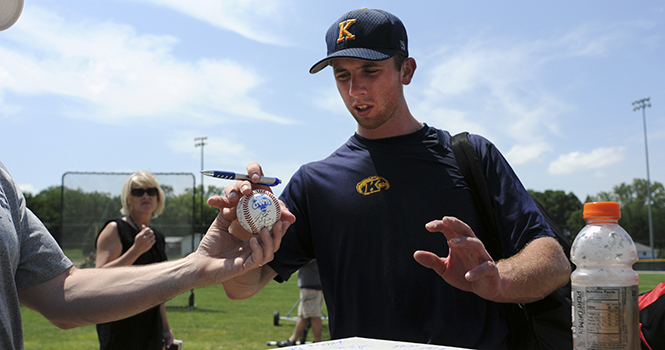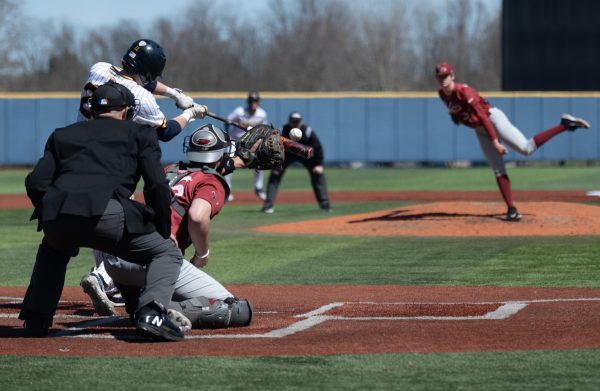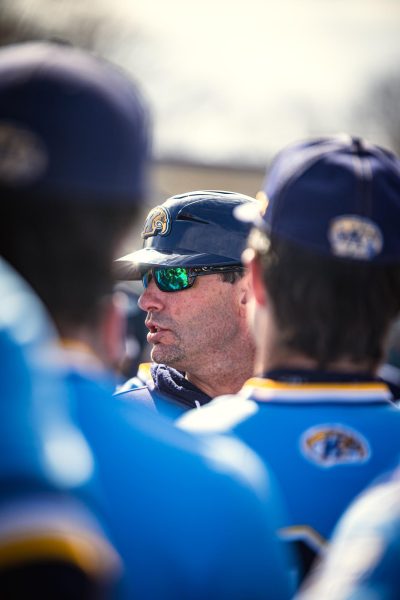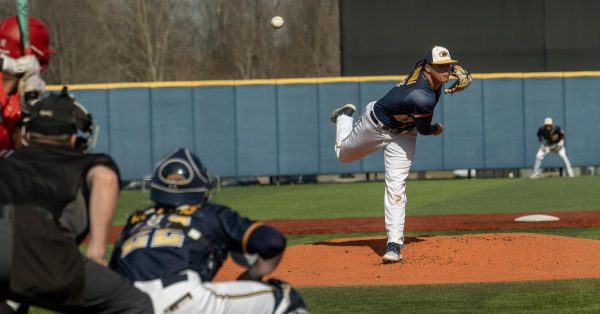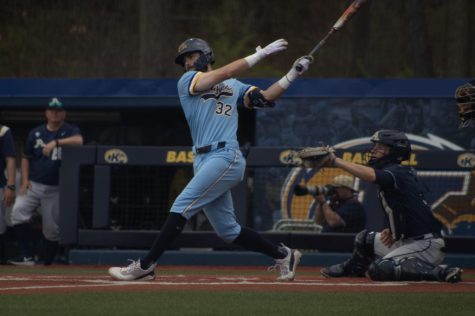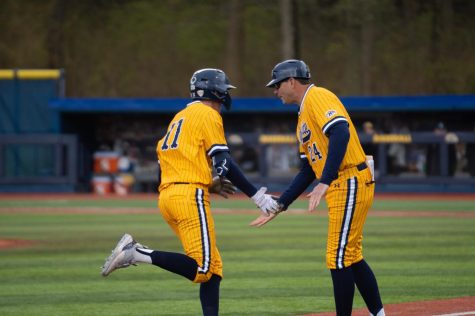Kent State baseball players, past and present, still feel draw of College World Series team (part 1 of 2)
February 5, 2013
Editor’s note: This is the first part of a two-part story about the journey of five former Kent State baseball players, who are now playing professionally, and how they remain connected to current KSU players. Read part 2 of the story here
Editor’s note: This is the first of a two-part story on members of the 2012 College World Series-qualifying Kent State baseball team.
The Cinderella run that the Kent State baseball team made last season will go down as one of the best sports moments in school history.
Over the course of three weeks in June, the Flashes defeated Kentucky in a marathon 21-inning game in the first round, went to Eugene, Ore., and eliminated the Oregon Ducks in the Super Regional, and knocked out the top-ranked Florida Gators in the College World Series.
But what happens next, after the magic ends?
In the case of the 2012 Flashes, five players selected in the MLB Draft turned pro, going their separate ways. Yet, the bonds that tie these players back to Kent State remain strong.
“The experience was awesome,” catcher David Lyon said recently of the 2012 season. “I’m so grateful that I was on a team that had that much chemistry, that much talent and could put it all together with a kind of run like that. Obviously that’s something I’ll never forget for my entire life.
“You grow up in high school, dreaming about playing in the College World Series and we were actually fortunate enough to play there. It’s just a once-in-a-lifetime thing that most people never even get the chance to do.”
Lyon was a force in the middle of Kent State’s lineup, posting a .282 batting average, .401 on-base percentage and .506 slugging percentage with 10 home runs and more walks (50) than strikeouts (42) in 65 games. He also served as the nominal captain of the team, though he was quick to defer to his teammates on the issue of leadership.
“All the seniors were captains, basically,” he said. “We voted on it, but pretty much all five seniors, me, Jim Rider, Dave Starn, Ryan Mace and Joe Koch, we pretty much were all kind of leaders in our different ways.”
One place Lyon cannot defer is in the case of on-field leadership. Lyon was trusted to handle calling pitches during his junior and senior year, a rarity at the college level.
“[The coaches] just kind of sat back and watched what happened,” Lyon said. “All the pitchers seemed to trust me and what I called. I always told them, ‘It’s your game, you throw what you want. But I’m just here to kind of guide you.’
“The majority of them didn’t really shake me off very much, maybe once or twice a game at most. So that was good that they trusted me and it seemed to work out for the team,” he said.
Lyon’s game calling helped the Flashes in 2012, and it also helped him as he transitioned into professional baseball. Drafted in the 34th round by the Texas Rangers, Lyon was assigned to their rookie team in the Arizona League. While there, Lyon’s pitch-calling experience at Kent State really paid off.
“During one point in the season down in Arizona we were kind of struggling,” he said. “We had video sessions and [the coaches] pretty much harped on the fact that you needed to be able to call the game, you had to be thinking a couple pitches ahead of time.
“I think calling all the pitches for two years in Kent definitely prepared me more and helped me to think pitches ahead and to read hitters, and know what pitches to throw as opposed to just throwing random signs down,” he said.
Lyon’s value on defense in pro ball is clear, but his offense is a little bit behind. He hit in the middle of the Kent State lineup, but after turning pro, Lyon got pushed down in the order. The adjustment was a new one for the catcher.
“Going from being one of the main hitters on the team [was difficult]” Lyon said. “I hit third for Kent. Going from that to hitting seventh, eighth, ninth [was hard]. I saw a lot of different pitches and a bunch of stuff I really wasn’t used to, so I really wasn’t prepared for that.”
The Arizona League Rangers were led by higher-level prospects like 2012 first round picks Lewis Brinson and Joey Gallo, though Lyon was a significant part of the team’s championship season. Another player that helped take the AZL Rangers to the top was former Kent State pitcher Ryan Bores.
Bores, selected in the 27th round of the draft, pitched 14.1 innings for the AZL Rangers, allowing eight hits, four walks, two runs and 12 strikeouts. That low innings total — 13th on the team — could have been boring for Bores, but having a friend in Arizona helped pass the time between outings.
“Me and David Lyon roomed together the whole year down in Arizona,” Bores said. “I had a roommate I got to hang out with the whole year that I knew from Kent, so that was pretty special.”
Bores had the option of turning pro a year earlier, as he was selected in the 26th round of the 2011 Draft, also by the Rangers. In the end, however, he decided that he was better served spending another year in school.
“I didn’t think I was ready to go play pro ball yet,” he said. “I didn’t really think I was going to get drafted, it kind of came out of nowhere at the last second.
“It was kind of a last second decision. I didn’t want to rush anything. Kent was obviously a great program, I wanted to go play there for a year, get better and it obviously worked out pretty well.”
Bores was a late addition to the Kent State team, transferring in from Cuyahoga Community College in Cleveland this past season. That did not stop him from finding out that the 2012 Flashes were a special group.
“We had a bunch of great players,” he said. “Everybody wanted to win more than anything. It was more of a team effort than individual, which was pretty cool to be a part of something like that. Somebody new every game did something special for us to win, so that was always real cool and interesting.”
With a 3.33 ERA, Bores was a strong option in the starting rotation for the Flashes. Unlike fellow starters David Starn and Tyler Skulina, however, Bores did not rack up strikeouts at a high pace. Instead, he relied on ball movement, location, and pitching-to-contact to get outs.
“I’ve always been more of a sinkerball pitcher, heavy two-seam fastball guy,” he said. “I have a good strikeout slider when I need it. When I go out there, I’m trying to make them put the ball in play and hit my pitch rather than strike them out.”
Bores may not have the best pure stuff on the mound, but he makes plenty of use of what he does have. That lack of pure stuff likely pushed him down draft boards in June, however — something that did not happen to Starn.
The highest Flash selected in the 2012 Draft, the Atlanta Braves picked Starn in the seventh round.
“I wouldn’t say it’s too much more pressure,” Starn said. “I’m just going to go out there and give it my best every time, so if I do that, I really have nothing to worry about. If I give it my all, I have no shame if I don’t succeed.”
Nor is he too worried about the aggressive promotion the Braves gave him straight out of Kent State. While the other drafted Flashes — including Jimmy Rider and Nick Hamilton — all started in the Arizona Rookie League, Starn found himself two levels above them in Single-A’s South Atlantic League.
“It was an honor that I got to do that,” he said. “But it wasn’t too much different than playing with some of the best college players around.”
Starn scuffled a bit after turning pro, posting a 5.50 ERA and 28:20 strikeout-to-walk ratio in 34.1 innings, but that should not obscure how dominant he was at Kent State. As a Flash, he posted a 2.48 ERA, struck out 127 batters in 119.2 innings, and served as the ace of the College World Series team.
“I learned a lot through my four years there,” he said of his time at Kent State. “Especially under [manager Scott] Stricklin and Birky [pitching coach Mike Birkbeck]. I learned a lot from Birky especially, because he was the pitching coach and he was probably the best around. He’s a guy that knows the game in and out and he’s got great connections to everyone, can’t say anything bad about him. They all think he’s one of the best coaches around in the nation.”
Starn is equally appreciative of the players he got the chance to play with at Kent State.
“The players that I got to grow up playing with through my four years there have been unreal,” he said. “I’ve made some great friendships and some great experiences. We’ve built the tradition of being one of the best and finally we got to achieve our number one goal and make it to the College World Series.”
Contact Jim Piascik at [email protected].


